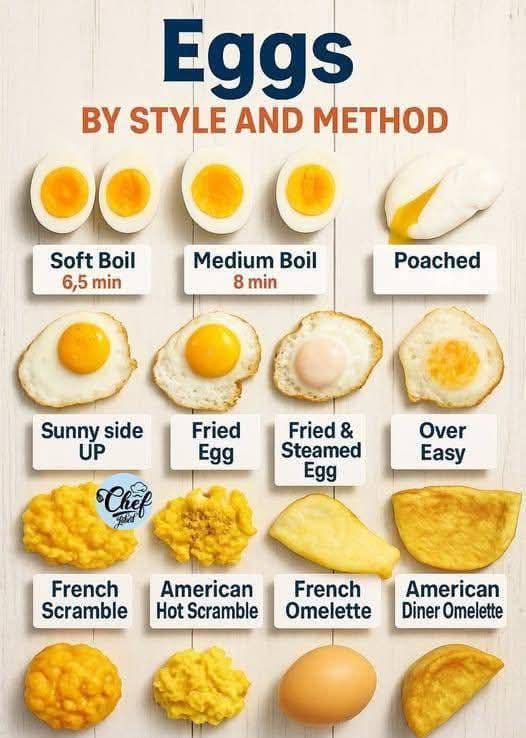Cooking Time: 3–4 minutes.
Texture: Soft white exterior with a runny, velvety yolk.
Best For: Eggs Benedict, avocado toast, grain bowls.
To poach eggs perfectly, crack a fresh egg into a small bowl, swirl the simmering water, and gently drop it in. Cook until the whites are just set, then remove with a slotted spoon.
3. Fried Eggs: Sunny Side, Over Easy, and More
Fried eggs are versatile and can be cooked in many styles depending on how much you want the yolk cooked.
Sunny Side Up
Cooking Method: Cooked on one side only, yolk facing up.
Texture: Fully cooked whites with a runny yolk.
Best For: Breakfast plates, rice dishes, or on top of burgers.
Over Easy
Cooking Method: Fried on both sides but yolk remains runny.
Texture: Whites are firm, yolk slightly cooked but still liquid.
Over Medium
Cooking Method: Similar to over easy, but cooked slightly longer.
Texture: Yolks are semi-set, not fully runny.
Over Hard
Cooking Method: Fried on both sides until the yolk is fully cooked.
Texture: Completely firm yolk, great for sandwiches.
Fried & Steamed Egg
This is a unique method where the egg is fried first, then a lid is placed on the pan to steam it, ensuring the yolk cooks slightly from above. This is often seen in Asian-style cooking.
4. Scrambled Eggs: French vs. American
Scrambled eggs may seem simple, but there are actually different styles depending on the method and heat used.
French Scramble
Cooking Method: Low and slow over gentle heat, stirred continuously.
Texture: Creamy, custard-like, very soft.
Best For: Elegant breakfasts, pairing with smoked salmon or fresh herbs.
American Hot Scramble
Cooking Method: Cooked quickly over medium-high heat, stirred less often.
Texture: Firm curds, fluffy, more structured.
Best For: Classic diner breakfasts.
Pro Tip: Adding a splash of cream or milk to scrambled eggs makes them extra soft and rich.
5. Omelettes: French vs. American
Omelettes are another egg dish where style makes a big difference.
French Omelette
Cooking Method: Whisked eggs cooked gently with butter, often folded without browning.
Texture: Soft, silky, almost custardy inside.
Best For: Minimal fillings like herbs or cheese.
American Diner Omelette
Cooking Method: Eggs are beaten, cooked until firmer, then filled with vegetables, cheese, or meats before folding.
Texture: Heartier, slightly browned, and more filling.
Best For: Big breakfasts and brunches.
Tips for Cooking Eggs Perfectly
Use Fresh Eggs – Especially important for poaching.
Control Heat – Low and slow for creamy textures, medium-high for firmer styles.
Season at the Right Time – Add salt toward the end of cooking scrambled eggs to avoid watery textures.
Don’t Overcook – Eggs continue to cook from residual heat even after removing them from the pan.
Conclusion
Eggs are not just breakfast food; they are a canvas for creativity in the kitchen. Whether you prefer them soft-boiled in a noodle soup, poached on toast, fried over rice, or scrambled for brunch, mastering the different cooking methods will elevate your everyday meals. By understanding timing, temperature, and technique, you can enjoy eggs exactly the way you like them, every single time.
ADVERTISEMENT

